Genetic algorithms
What is the problem?
Suppose you have a system which you want to control. The reason for this
could be to achieve better performance for instance. In the situation depicted
here one may want to adjust the parameters of the system in order to produces
more little man . Of course for real life applications a lot of
factors have to be taken into account. If you increase the speed of the
conveyer belt for instance you will be required to make some change to
other parameters as well. And maybe this will influence some part of the
production process in ways that are difficult to predict. And so you may
end up having little men with different shapes because of the interactions
that specific to that very machine. This can be summarized by saying that
there are some non-linearities in the system which are very difficult to
model and even more to compute. So why try to model what the machine will
do? You can do it for small systems but what about real big ones? (Note
that the system can be a game, computer program or a machine.)
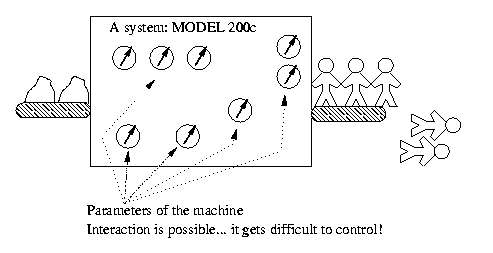
The idea: evolution
Instead of modelling the system why not try different solutions on it?
This of course implies that it is indeed save to submit the system to a
series of experiments. Just try different set of parameters and
see how well they perform. This allows you to determine the fitness
of a solution. Based on the fitness you can retain some of the best solutions
and throw away the bad ones. In this way you introduce some selection
which will help you improve you solutions.
But before going any further it is important to introduce the term individual.
Until now this has been call a solution but individual is term used in
the literature. So, one such individual can be viewed as consisting of
2 elements: its GENE and its fitness. The gene being in the
example given above the different parameters of the system. A collection
of individuals is generally called a population. A population will
change over time (see later) and will consist of different generations
of individuals.
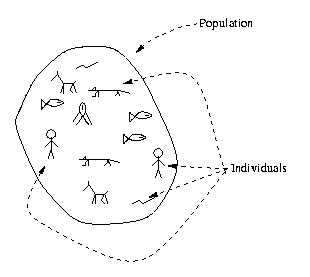
Let us resume at this point using the brief terminology introduced above.
You take a population (a collection of individuals) and determine the fitness
of each individual. In a next step you use a policy to retain some of the
solution (usually the best ones). Since some individuals where discarded
you need to introduce new ones in the population. This is done by using
genetic
operators. These are applied on the remaining individuals in the hope
the improve the population (that how we improve). We have a new population
(or partly at least) we can restart the cycle.
By using both a selection process and genetic operators bad individuals
are removed and new ones are generated with possibly greater potential.
Does it always work?
Hmm ... not with me :-{ Although genetic algorithms can indeed find good
solution and even surprising ones it is still no magic.
Important factors are the evaluation for example. If the function is
to strict for instance the likely hood of success it remote. If your evaluation
function (to look at it from the programming side) computes finesses in
a rather bimodal way (that is to say: or you are good or you are
real bad) then the fitness would give a bad indication about the quality
of an individual. This makes it very hard to compare good ones with each
other for instance.
Another factor is the size of the population. Of course the workload
is affected by this choice but the quality and the speed of the genetic
algorithm as well. To put it simple you can give more space for a good
solution to appear early if you use a big population. But then again there
is no guarantee about that either.
Yet other important parameters are related to the choice (probabilities)
of the genetic operators and the selection criterion used.
Phases
The number of step of genetic algorithm in its simplest form are fairly
small:
-
Generate a random population to start with (the first generation)
-
Evaluate the entire population
-
Apply the selection criterion
-
Use evolution to create new individuals (next generation)
-
Restart at step 2
Initial random population
This is quite obvious I guess fill your generation with randomly generated
individuals.
Note: the fact that this is random is important as the genetic
diversity will allow new solution to emerge.
Evaluation
This step is depends on the problem at hand. As the individual is of course
evaluate within the context of the problem we try to solve/optimize. The
fitness of each individual is determined in this step.
Selection
At this point it is possible to choose those individuals who are performing
well for what we want to achieve. All the other ones are not suitable and
will be discarded here. As a result we end up with a smaller population.
Different criterion can be used. It is of course a choice the as to be
made by the programmer.
-
By far the easiest approach is to used a TOP N policy. At each selection
step only the N best individuals will survive.
-
Another approach is to set a threshold for the fitness. Every individual
with a fitness higher than the threshold will remain.
-
Another approach is the used of tournaments. Two individual are chosen
at random and compete again each other. The one with the highest fitness
wins for example.
-
Yet another approach is roulette selection. Many variations can be proposed.
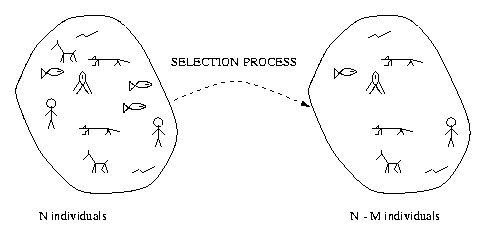
Genetic operators
In this step we use the better individuals to repopulate our genetic pool.
We can do this using genetic operators which work at the gene level. The
operation performed are combination, modification and duplication. The
selection of the different genetic operations usually happens at random.
But in order to steer the genetic algorithm probabilities are introduced
in the process. (Like 85% probability for one operator, 10% for another
etc..)
-
Crossover: combines the gene of two individuals by splitting them at a
randomly chosen point and interchanging the segments. Since this process
creates 2 new genes one usually chooses one of them at random.
-
Mutation: here a gene of individual is simply duplicated but an error is
introduced on purpose in the process. Mutation are the major source of
surprising
results. A mutant can indeed turn out to perform quite well compared
to others. And if not it will be illuminated quite naturally at the selection
step.
-
Copy: this pure duplication, hereby the influence of a solution in the
population increases. This fosters the chances of survival of the individual's
gene.
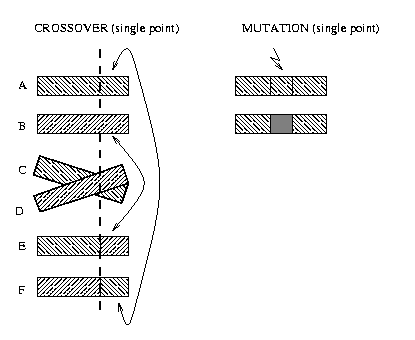
The new individuals are thus combinations or mutations of the individuals
that were retained by the selection process. An attempt has been done to
illustrate this. One can see that in the new population a centaur
appeared (combination of horse and man). Some of the new
individuals will indeed turn out to be better some not but this is of no
concern at this point.
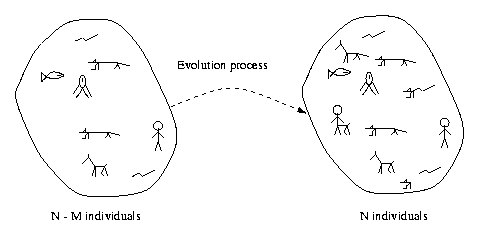
When to stop?
How many times do we have to cycle trough the entire process? Well there
are 2 situations one can distinguish:
-
The problem we try to solve has an optimal solution and we found
it. In that case it is quite obvious that there is not reason to continue.
One can of course define optimal in different ways. (For example
when the error is small the epsilon)
-
In the other case we will have to settle for a good solution, that
is a solution that can be considered not satisfactory for what we want
to achieve. Usually this means we limit the number of generations. The
genetic algorithm will be stop after a certain number of cycles and the
best individual will be used.
Document was written by Parent Johan (January 2000)





